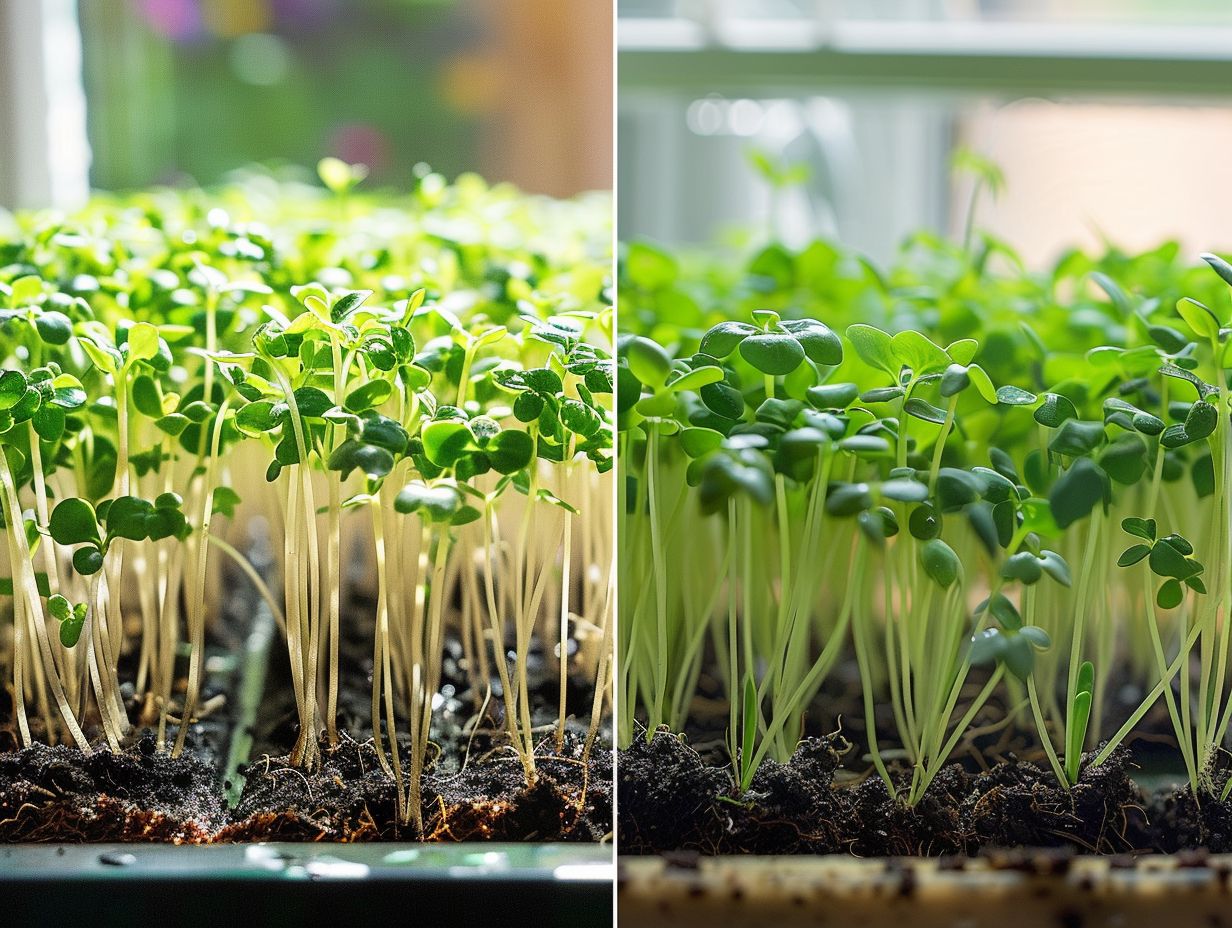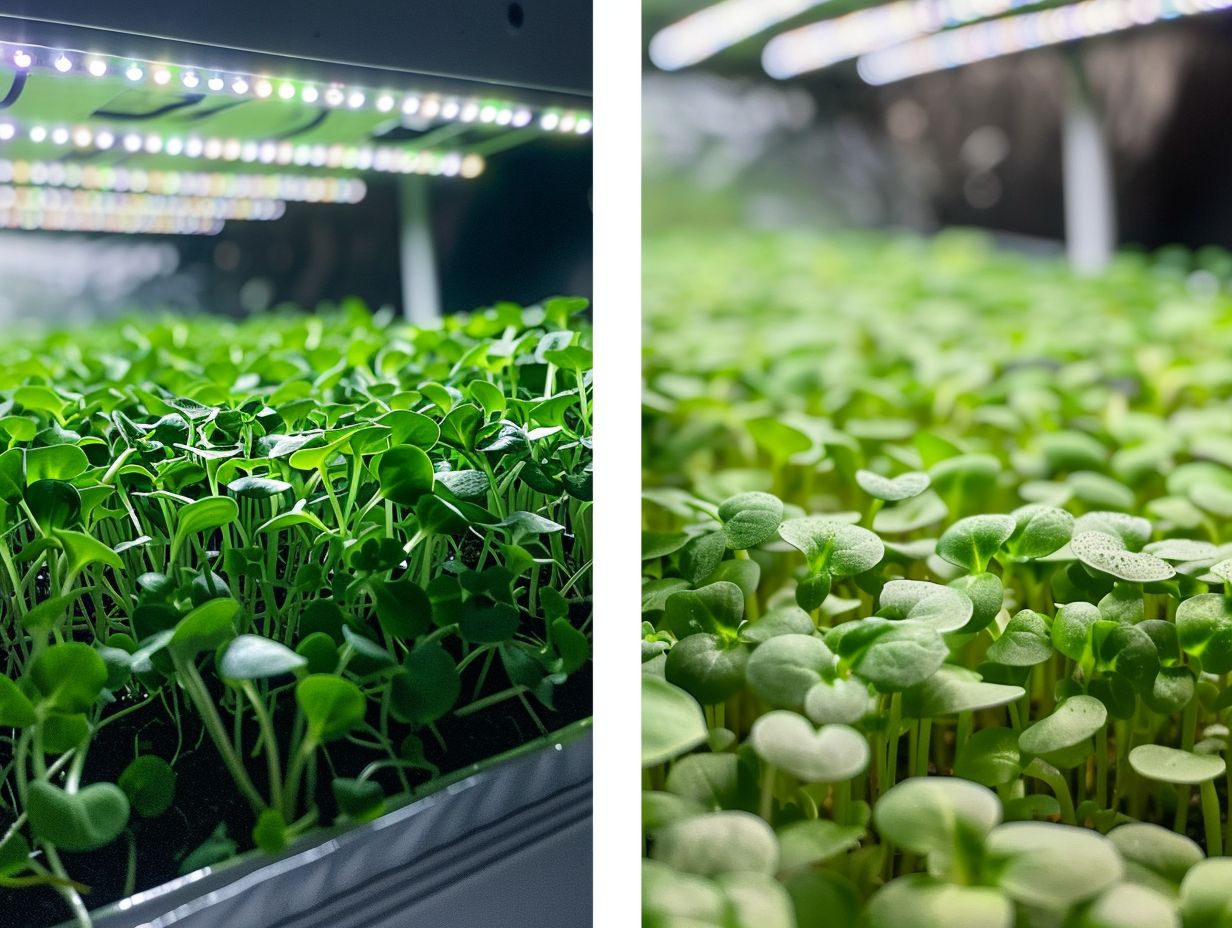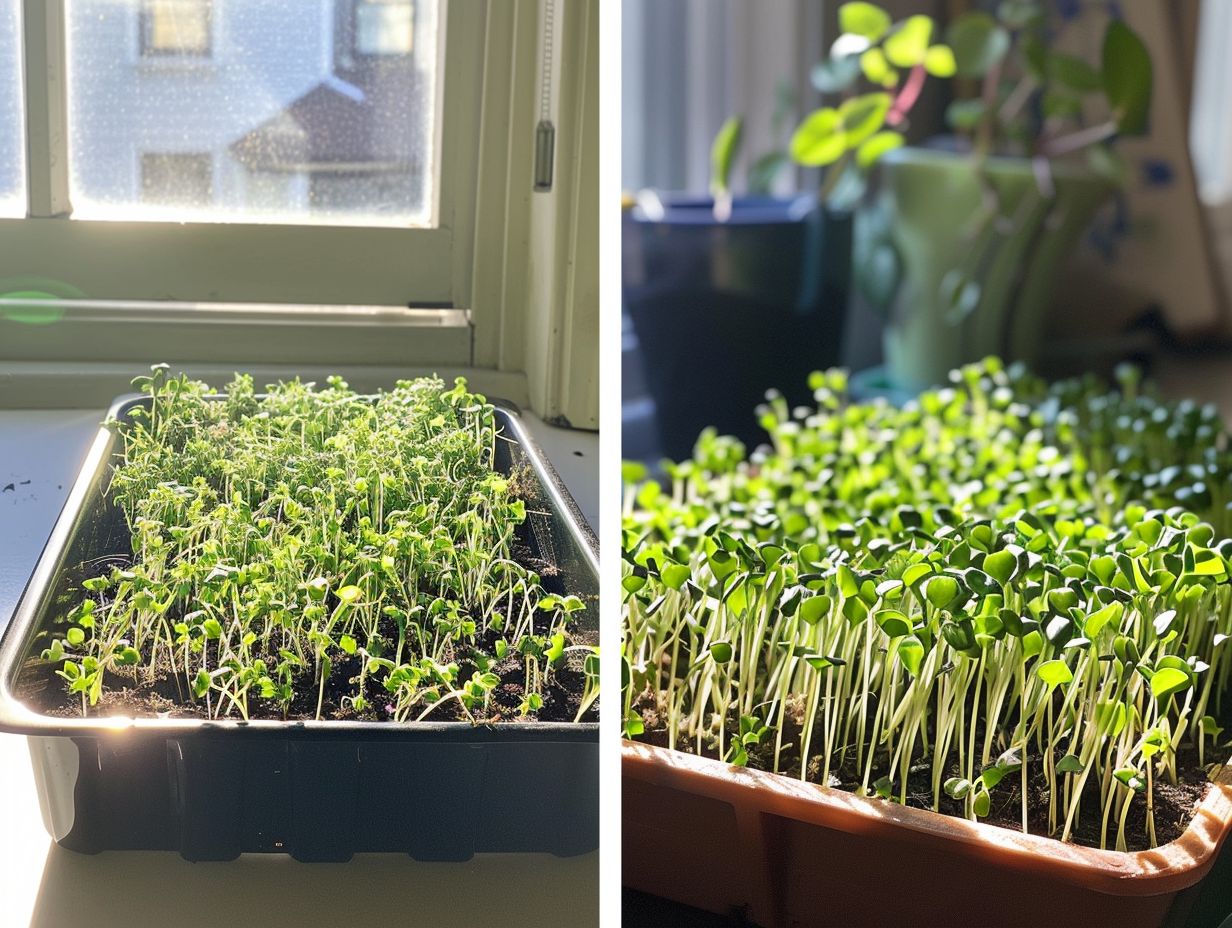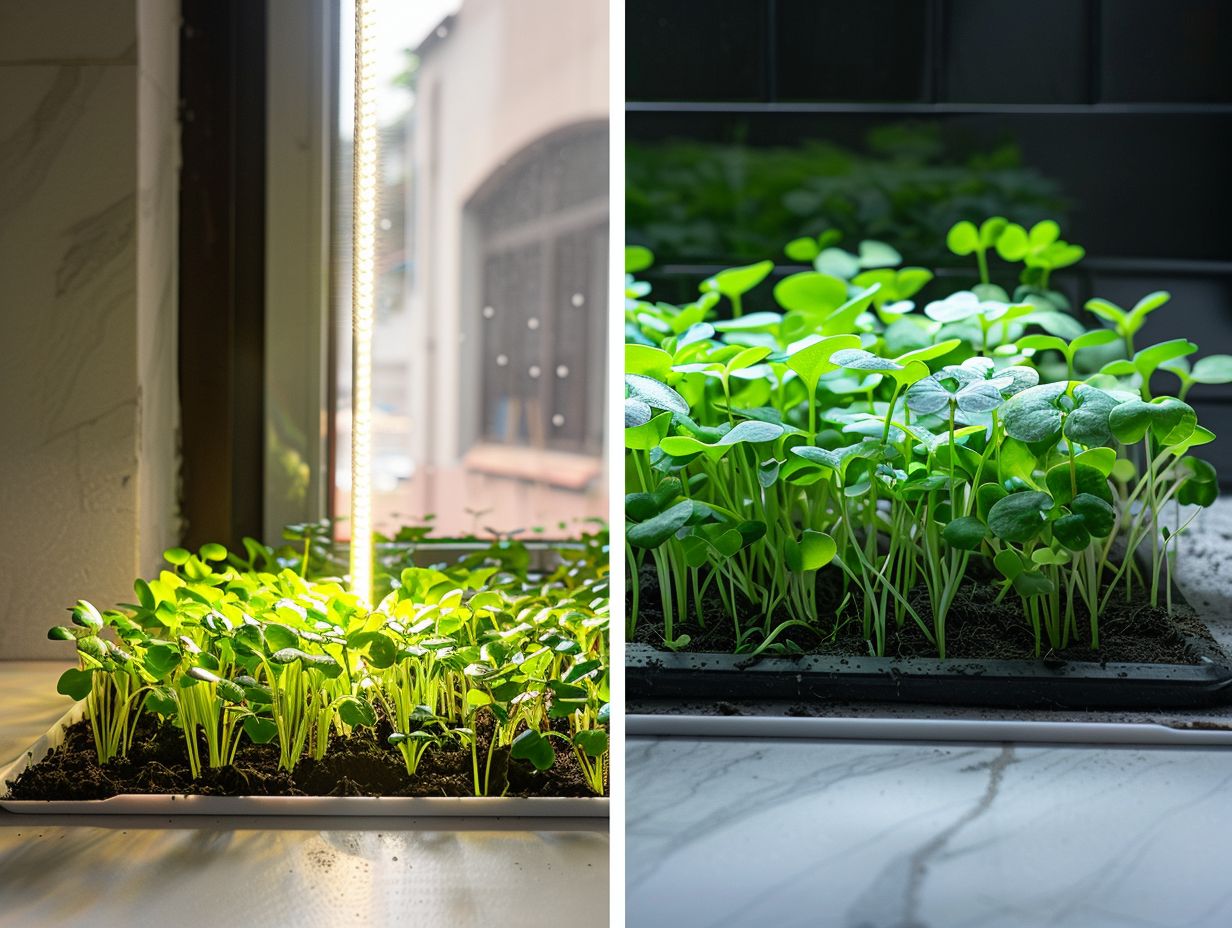Curious about how to grow microgreens at home? One key factor to consider is the type of light you use.
We delve into the importance of light for microgreen growth, comparing sunlight to artificial light. We discuss the pros and cons of each option, as well as factors to consider when choosing the best light source for your microgreens.
Whether you prefer natural sunlight or artificial light, we provide tips on how to use each for optimal growth. Find out which light source is best for your microgreens!
Key Takeaways:

What Are Microgreens?
Microgreens are young vegetable greens that are approximately 1-3 inches tall and are harvested just after the first true leaves appear.
These miniature versions of common vegetables like lettuce, spinach, and arugula are packed with flavor and nutrients. Despite their small size, microgreens boast intense flavors ranging from mild to spicy, making them popular additions to dishes for both taste and aesthetics.
The growth cycle of microgreens typically ranges from 7 to 21 days, depending on the type of plant. Common types include broccoli, kale, radish, and mustard greens. These vibrant greens are not only visually appealing but also rich in essential nutrients such as chlorophyll, vitamins, and antioxidants, making them a powerhouse of health benefits.
The Importance of Light for Microgreen Growth
Light plays a crucial role in the growth of microgreens as it is essential for photosynthesis, the process through which plants convert light energy into chemical energy. Chlorophyll, the pigment responsible for capturing light, is abundant in microgreens, emphasizing their need for a proper light source.
The relationship between light, chlorophyll, and photosynthesis in microgreens is fundamental to their development. When light hits the chlorophyll molecules within the plants, it initiates the process of photosynthesis, enabling them to produce sugars for growth. Without adequate light exposure, microgreens struggle to generate the necessary energy for their metabolic processes. This connection underscores the crucial role that light plays in enabling microgreens to thrive and reach their full potential.
What Type of Light Do Microgreens Need?
Microgreens require a specific type of light spectrum for optimal growth, preferably in the range of 4600K-6500K. LED lights and T8 fluorescent lights are popular choices for providing the necessary light spectrum to support healthy microgreen development.
LED lights have gained popularity due to their energy efficiency and ability to emit light in the necessary spectrum for photosynthesis, promoting strong stems and vibrant leaves in microgreens. On the other hand, fluorescent lights, especially the T8 type, offer a cost-effective alternative with good light output, although they may not last as long as LEDs.
It’s important to note that the light spectrum directly impacts the growth rate, appearance, and even the taste of microgreens. Blue light, found in the 460-470nm range, boosts leaf development and overall plant growth, while red light, around 660nm, enhances flowering and fruiting.
Sunlight vs. Artificial Light
Regarding providing light for microgreens, growers have the option to use either natural sunlight or artificial light sources such as LED or T8 fluorescent lights. Each light source has its advantages and considerations for the optimal growth of microgreens.
One of the key benefits of natural sunlight is its full spectrum, which provides a well-rounded light environment for the plants, aiding in robust growth and nutrient synthesis. On the other hand, artificial lights like LEDs offer the advantage of energy efficiency and customizability, allowing growers to tailor the light spectrum and intensity to the specific needs of different microgreen varieties. Relying solely on natural sunlight can be challenging due to seasonal variations and potential limitations in indoor settings, whereas artificial lights can provide consistent illumination regardless of external conditions.
Pros and Cons of Sunlight for Microgreens
 Sunlight is a natural and cost-effective light source that provides microgreens with the full spectrum of light they need for optimal growth. Managing sunlight exposure can be challenging, leading to issues like leggy microgreens and the need for indirect light to prevent overexposure during peak hours.
Sunlight is a natural and cost-effective light source that provides microgreens with the full spectrum of light they need for optimal growth. Managing sunlight exposure can be challenging, leading to issues like leggy microgreens and the need for indirect light to prevent overexposure during peak hours.
Optimal growth conditions for microgreens under sunlight include ensuring they receive around 6-8 hours of direct sunlight per day. This exposure helps in the photosynthesis process, crucial for their development. On the other hand, too much direct sunlight can lead to scorching. Indirect lighting strategies such as using shade cloth or adjusting the angle of the light source can help regulate exposure. Timing is key when harvesting sun-grown microgreens, as picking them in the morning can result in maximum freshness and nutrition.
Pros and Cons of Artificial Light for Microgreens
Artificial light sources like LED and T8 fluorescent lights offer growers control over the intensity and duration of light exposure, ensuring consistent growth conditions for microgreens. Determining the optimal light distance and spectrum can be crucial for achieving successful results.
Light intensity plays a pivotal role in the growth of microgreens, influencing factors such as photosynthesis and overall plant health. Growers must carefully calibrate the distance between the light source and the plants to prevent issues like light burn or insufficient light penetration. Selecting the right light spectrum is essential as different wavelengths can impact plant growth stages. While artificial lighting can provide year-round cultivation opportunities and precise light control, it may also lead to higher energy costs and potential heat accumulation if not managed efficiently.
Factors to Consider When Choosing Light for Microgreens
When selecting a light source for growing microgreens, several key factors need to be considered. These include the cost of the lighting system, its availability, the light spectrum it provides, and the intensity required for optimal growth.
One of the most crucial elements to consider is spectrum suitability – the specific wavelengths of light essential for photosynthesis and overall plant development. Different growth stages of microgreens require varying light spectrums to thrive efficiently.
The cost-effectiveness of the lighting system plays a significant role in the long-term sustainability of microgreen cultivation. Opting for energy-efficient LEDs, for example, can lower electricity bills while providing tailored lighting solutions.
Ensuring that the light source offers adequate intensity is vital. Insufficient light intensity can lead to elongated stems and pale leaves, affecting the quality and yield of the microgreens.
Cost
The cost of setting up a lighting system for microgreens can vary depending on the type of grow lights chosen. LED lights may have a higher initial cost but lower long-term energy consumption, while fluorescent lights are more affordable upfront but may incur higher electricity expenses.
When considering the initial investment, LED lights stand out for their efficiency and durability, making them cost-effective in the long run. Despite the higher price tag at the outset, their energy-saving benefits result in reduced electricity bills, contributing to savings over time.
In contrast, fluorescent lights provide a budget-friendly alternative for those with limited upfront funds, yet the ongoing operational costs can add up, especially in terms of electricity usage.
Evaluating the cost-effectiveness of these lighting systems requires a comprehensive analysis of both the initial and long-term expenses associated with each option.
Availability
The availability of light sources like LED strip lights can influence the ease of setting up a microgreen growing environment. LED strip lights are often versatile and widely accessible, making them a convenient choice for growers seeking readily available lighting solutions.
LED strip lights offer numerous benefits for microgreen cultivation, such as their energy efficiency and customizable features that enable growers to adjust light intensity and spectrum according to plant requirements. The compact size of LED strips allows for easy installation in small spaces, perfect for indoor growing setups. The low heat emission of LED lights prevents damage to delicate microgreens, ensuring optimal growth conditions for a successful harvest. With their long lifespan and low maintenance requirements, LED strip lights have become a popular choice among both novice and experienced growers alike.
Control and Consistency
 Maintaining control and consistency in light exposure is crucial for ensuring the healthy growth of microgreens throughout their growing cycles. Growers must establish a regular lighting schedule to mimic natural daylight patterns and promote consistent development.
Maintaining control and consistency in light exposure is crucial for ensuring the healthy growth of microgreens throughout their growing cycles. Growers must establish a regular lighting schedule to mimic natural daylight patterns and promote consistent development.
Consistency in light management aids in regulating essential processes such as photosynthesis and nutrient absorption, which are pivotal for the development of robust microgreens. By adhering to precise lighting schedules, growers can optimize the growth stages and ensure the proper formation of leaves and stems. Proper lighting also influences factors like flavor, texture, and color of microgreens, making it a key aspect in cultivation. A well-structured lighting regime not only supports healthy growth but also contributes to the overall quality of the microgreens produced.
Spectrum and Intensity
The spectrum and intensity of light play a critical role in determining the growth and quality of microgreens. Choosing the right color temperature and adjusting the light intensity based on the growth stage are essential factors for optimizing the cultivation process.
Regarding microgreen cultivation, understanding the light spectrum is akin to knowing the language of plants. Different light wavelengths impact photosynthesis, influencing aspects like leaf development, nutrient content, and overall plant health. For instance, blue light tends to promote compact growth, while red light encourages elongation.
Moreover, light intensity directly affects how efficiently plants can convert light into energy. Strike the right balance, and you’ll witness vigorous growth; however, too much or too little light can hinder the photosynthesis process and alter the flavor, texture, and nutritional profile of the microgreens.
How to Use Sunlight for Microgreen Growth
Utilizing sunlight for microgreen growth requires adequate placement to ensure proper exposure. Growers should position their trays in locations with indirect sunlight, provide sufficient water and nutrients, and monitor soil moisture levels to support healthy development.
When positioning trays for optimal sunlight exposure, consider the orientation of the light source to avoid direct and intense rays that may scorch the delicate shoots. Placing the trays near a window with sheer curtains or in a sun-dappled area can offer the ideal balance of light diffusion. Rotating the trays periodically ensures even access to sunlight from all angles, promoting uniform growth.
For soil preparation, choose a well-draining medium rich in organic matter to support root development while preventing waterlogging. A mix of organic compost and peat moss provides essential nutrients and maintains adequate moisture levels for sustained growth.
Watering techniques play a crucial role in microgreen cultivation. Keep soil consistently moist but not waterlogged through gentle misting or bottom watering to avoid disturbing the delicate roots. Adjust watering frequency based on environmental conditions to prevent drying out or over-saturation.
In terms of nutrient management, consider supplementing with a balanced fertilizer or organic amendments to ensure microgreens receive essential nutrients for robust growth. Regularly check the pH levels of the soil to maintain an optimal growing environment that supports nutrient uptake and overall health.
How to Use Artificial Light for Microgreen Growth
Artificial light sources can be optimized for microgreen growth by selecting the appropriate color temperature and ensuring adequate luminosity (measured in lumens). Adjusting the light setup based on the specific requirements of different microgreen varieties is key to successful cultivation.
Color temperature plays a crucial role in influencing the growth stages of microgreens. For instance, blue light with a higher color temperature promotes vegetative growth, while red light encourages flowering and fruiting. It’s important to strike a balance between these light spectrums to achieve optimal results across various stages of microgreen development. Varying lumen levels should be tailored to the growth phase of the microgreens to provide them with the right intensity of light for photosynthesis.
Conclusion: Which is Best for Microgreen Growth?
Determining the best light source for microgreen growth depends on various factors, including accessibility, cost, and growth requirements. While sunlight offers natural benefits, artificial light options like LED and T5 LED lights provide controlled environments that cater to specific microgreen needs.
LED lights are energy-efficient and emit specific wavelengths ideal for photosynthesis, promoting better growth and yield than traditional lighting sources. On the other hand, T5 LED lights are great for creating a balance between blue and red spectrum, crucial for different growth stages of microgreens.
Sunlight, while abundant and cost-effective, may not always provide consistent lighting levels and can be challenging to control for indoor crops. A combination of natural and artificial light can be a viable strategy for maximizing growth potential and achieving optimal results in microgreen cultivation.
Frequently Asked Questions

What are microgreens?
Microgreens are young vegetable plants that are harvested after the first true leaves have developed. They are usually between 1-3 inches tall and have a more intense flavor compared to their mature counterparts.
Why is light important for microgreen growth?
Light is essential for photosynthesis, the process by which plants convert light energy into chemical energy. This energy is then used to fuel plant growth and development.
What is the difference between sunlight and artificial light?
Sunlight is the natural light that comes from the sun, while artificial light is any type of light that is produced by man-made sources, such as light bulbs or grow lights.
Which type of light is best for microgreen growth?
Both sunlight and artificial light can be suitable for microgreen growth, but each has its advantages and disadvantages. Sunlight provides a full spectrum of light, while artificial light can be controlled for specific wavelengths and intensity.
Can microgreens be grown solely under artificial light?
Yes, microgreens can be grown solely under artificial light, as long as the light source provides the necessary spectrum and intensity for photosynthesis.
What is the recommended amount of light for microgreen growth?
Microgreens typically require 10-14 hours of light per day for optimal growth. However, the exact amount may vary depending on the type of microgreens and the light source being used.
Leave a Reply